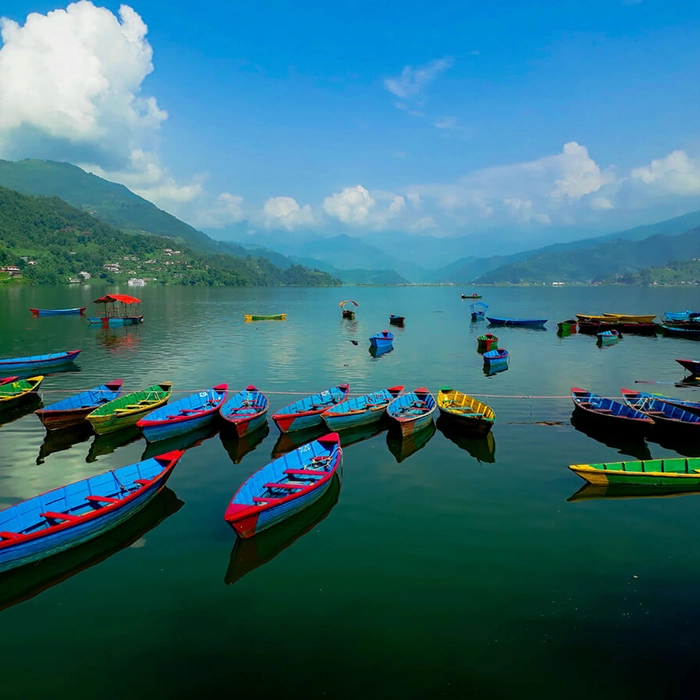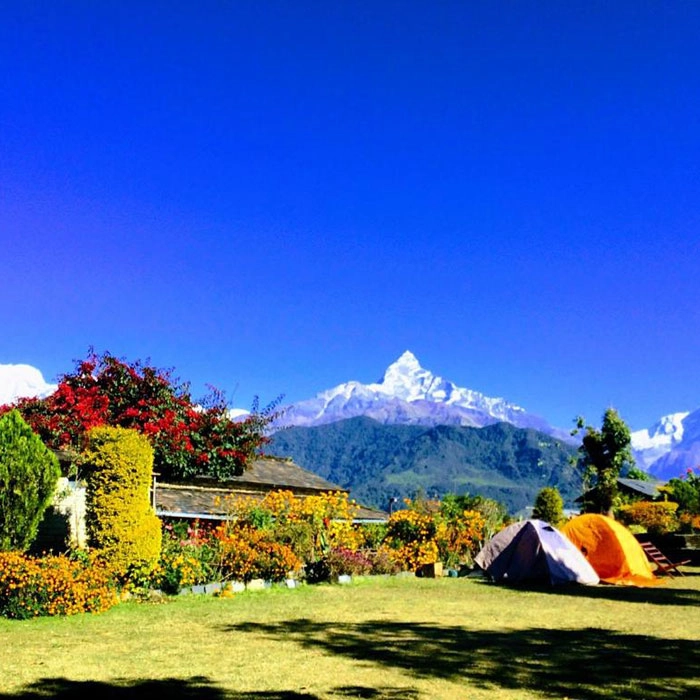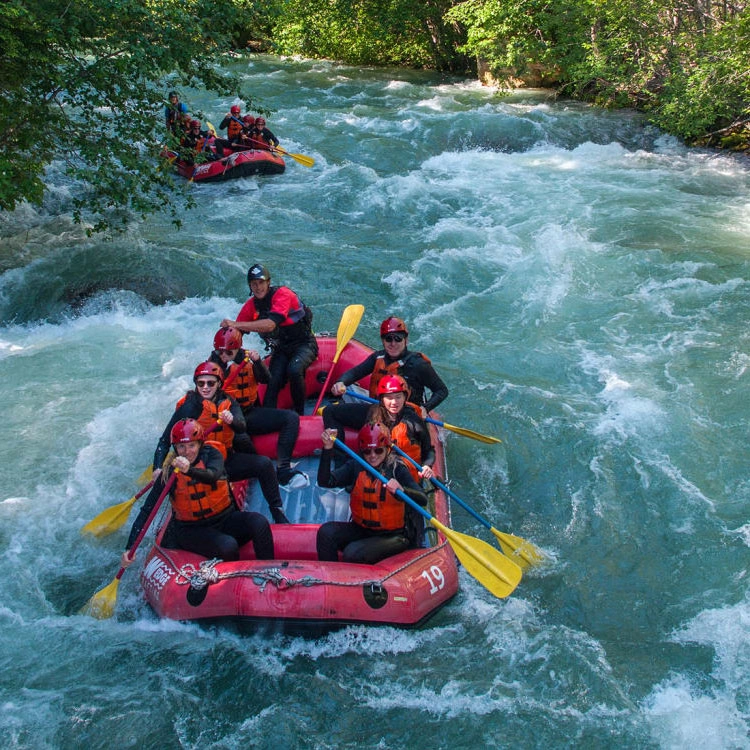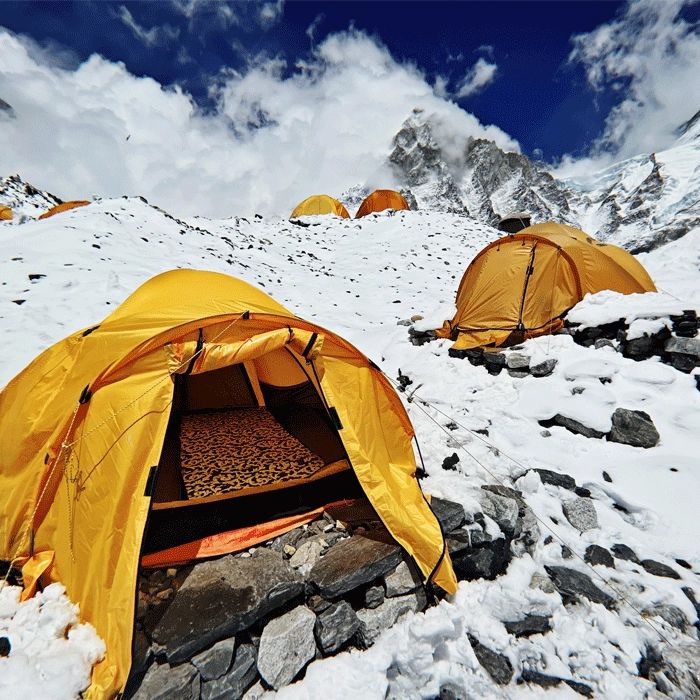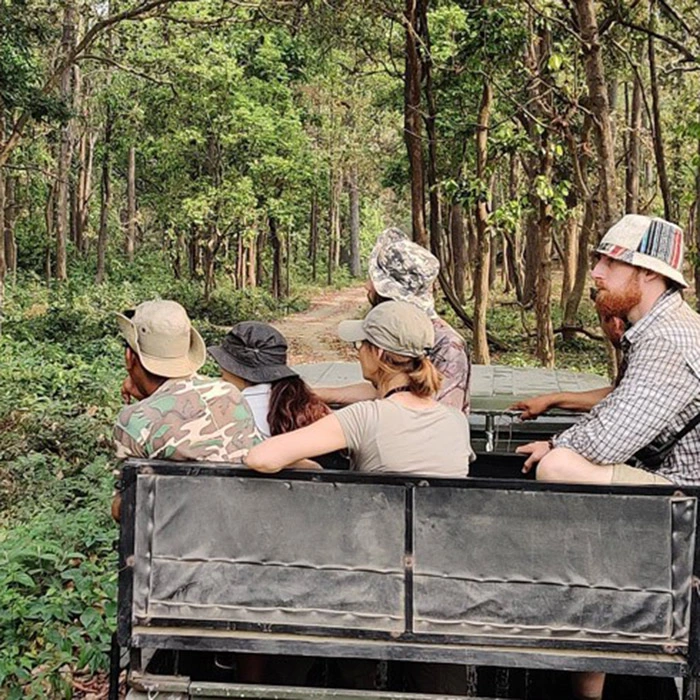ANNAPURNA SPIRITUAL JOURNEY
US$2,300.00
/pp
-
9 Days
-
Annapurna
-
Spring/Autumn
-
Trekking
-
2,012 Meters
-
Easy
-
Bus / Plane
-
02-16 People
-
JH#219-L
 Overviews
Overviews
Begin your journey with a scenic drive from the vibrant city of Pokhara, winding through lush landscapes until you reach Dhawa, where your trek officially begins. From here, the path gently climbs toward Birethanti, guiding you deeper into the heart of the Annapurna Conservation Area. The trail soon leads to the enchanting Gurung village of Ghandruk, a cultural jewel perched high in the hills and known as the central hub of this pristine region. Spend a day wandering through its narrow lanes and terraced fields, soaking in the rich history and vibrant traditions that pulse through the town. Explore the foothills of Annapurna and the heart of the Himalayas on this rewarding short trek that perfectly blends scenic trekking with cultural sightseeing. Experience vibrant music, dance, and the warm hospitality of the Gurung people as you discover picturesque villages nestled in the Himalayan foothills.As you continue, descend gracefully into the dramatic gorge carved by the roaring Modi Khola River, a natural spectacle that contrasts with the serene mountain vistas surrounding you. The trail then meanders through honey-scented forests and farmlands to Landruk, where the comforting embrace of a Mountain Lodge awaits you each evening. Your route unfolds further through the charming villages of Majgaon, Tomijong, and Dhampus, each offering a unique glimpse into local life and hospitality. These stone villages, framed by towering peaks, become your resting places, where warmth and comfort replace the day’s exertions. Beyond the trek, additional nights in Pokhara and Kathmandu promise even more cultural experiences and unforgettable adventures. As you journey through this remarkable landscape, you’ll traverse fields of golden millet and swaying maize, cross slender suspension bridges spanning rushing rivers, and ascend centuries-old stone staircases carved into the mountainsides. The sacred peaks of Machapuchare and the Annapurna range watch over you, their majestic presence a constant reminder of the Himalayas’ grandeur. Each village along the way welcomes you with open arms, where the Gurung people—known for their genuine warmth and joyful spirit—invite you to share in their daily lives. Picture yourself savoring a steaming cup of chai outside a traditional teahouse, while panoramic views stretch endlessly before you. Taste the freshness of locally grown produce, browse through quaint shops filled with handcrafted treasures, and visit tranquil monasteries where ancient chants still echo softly. On nearby farms, children’s laughter mingles with the clucking of chickens, creating a lively soundtrack to your evenings. Share stories and smiles with fellow travelers around a crackling fire, then retire to the soothing comfort of your mountain lodge, where restful nights prepare you for the next day’s adventure. The Gurung people, whose name means “Tamu” — with “Ta” symbolizing thunder and “mu” representing the sky — are a proud and resilient Tibeto-Burman ethnic group who have inhabited Nepal’s mid-hill slopes for millennia. Their culture is a rich tapestry woven from Buddhist, Hindu, and animist beliefs, creating a unique spiritual harmony. Renowned not only for their warm hospitality but also for their valor, many Gurung men have earned distinction as the legendary Gurkhas, elite soldiers who have served in the British and Indian armies with honor. These veterans, often wearing their medals proudly, are eager to share captivating tales of courage and history. The Gurung women, respected as equals within their communities, are often seen gathered in sunlight, exchanging lively banter or preparing traditional delicacies with skill and care. Meanwhile, the children bring boundless energy and curiosity, delighting visitors with their bright smiles and playful spirit. Embark on this unforgettable Annapurna Spiritual Journey and connect deeply with nature and culture alike. Book your adventure today! Annapurna Spiritual Journey DifficultyThe Annapurna Spiritual Journey is a moderate, easy-to-moderate trek suitable for travelers with basic fitness. Daily hikes last 4–7 hours, passing through forests, terraced fields, sacred monasteries, and traditional Himalayan villages. Trails involve gentle to moderate ascents, reaching Australian Camp at 2,055 meters, the highest point on this trek, and Ghandruk at 2,012 meters, the second-highest point. No technical climbing is required, and the trek’s pace allows for meditation, reflection, and cultural experiences, making it accessible even for first-time spiritual trekkers with proper preparation. Annapurna Spiritual Journey CostThe Annapurna Spiritual Journey trek is a highly rewarding Himalayan adventure in Nepal. The cost generally includes a licensed trekking guide, porter support, ACAP (Annapurna Conservation Area Permit), teahouse accommodations, daily meals, and ground transportation from Pokhara. Solo trekkers enjoy personalized attention, while group trekkers benefit from discounted group rates, with per-person prices decreasing as group size increases. Special seasonal promotions and customized trekking packages are available. While rates reflect standard international pricing, contact us for personalized Annapurna Spiritual Journey offers. Our aim is to provide the best value Himalayan trekking experience without compromising comfort, safety, or the unforgettable spiritual adventure.
 Itinerary (Plan)
Itinerary (Plan)
Welcome to Kathmandu, Nepal’s vibrant cultural heart and the gateway to your unforgettable Annapurna Spiritual Journey! Upon your arrival at Tribhuvan International Airport, the warm and attentive Jagadamba Holidays team will greet you and escort you to your comfortable hotel located in the lively city center. Today is all about relaxing, acclimatizing, and preparing yourself for the incredible adventure that lies ahead.
Kathmandu is a vibrant metropolis where centuries-old traditions coexist beautifully alongside contemporary urban life, creating an enchanting atmosphere that will welcome you at every turn. If time allows, take a leisurely stroll to Durbar Square, a UNESCO World Heritage Site renowned for its centuries-old temples, palaces, and intricate wood carvings. This vibrant hub offers a first glimpse into Nepal’s rich culture and warm community spirit, setting the perfect tone for your journey.
Before dinner, our expert guides will hold a detailed briefing to equip you with essential information about the trek, including safety tips, cultural insights, and what to expect on the trail. This session is a great opportunity to ask questions and build excitement for the days to come.
Enjoy your first taste of Nepalese cuisine at a local restaurant, savoring traditional dishes such as dal bhat (lentil soup with rice), momos (Nepali dumplings), and gundruk (fermented leafy greens). These flavorful meals offer a nourishing introduction to the region’s culinary heritage.
As your day winds down, settle into your cozy hotel and get a good night’s rest. Tomorrow, you’ll take a scenic flight to Pokhara, the picturesque starting point of your Himalayan trekking adventure.
Begin your unforgettable Annapurna Spiritual Journey with a breathtaking 25-minute flight from Kathmandu to Pokhara, the serene gateway to Nepal’s majestic Annapurna mountain range. As your plane descends, be mesmerized by panoramic views of snow-capped Himalayan peaks reflected on the serene waters of Phewa Lake. Pokhara’s vibrant lakeside atmosphere, nestled between towering mountains and lush greenery, offers a perfect introduction to your spiritual trek.
From Pokhara, enjoy a picturesque 1.5-hour drive covering about 48 kilometers through lush valleys and traditional villages, passing terraced fields cultivated with millet, maize, and rice. The drive to Dhawa immerses you in rural Nepali life, where friendly villagers and playful children greet travelers with warm smiles.
Arriving in Dhawa, the trekking officially begins. From here, you embark on a gentle 3-hour trek covering approximately 5 kilometers to Birethanti. During this stretch, you will experience a gradual ascent of about 100 meters, as the trail climbs from Dhawa’s altitude of roughly 1,050 meters to Birethanti at about 1,097 meters. Along the way, the path also includes some mild descents totaling around 125 meters, making the trail a gentle mix of ups and downs.
Discover scenic trails beside the Modi Khola River, where vibrant rhododendron and oak trees create a canopy filled with the melodies of birds and the gentle flutter of butterflies. The soothing sounds of rushing water and nature’s symphony accompany you as you cross charming suspension bridges and navigate well-worn mountain paths.
Your destination is Birethanti, a lively village serving as a popular trailhead for Annapurna treks. Here, local guesthouses and teahouses offer comfortable lodging and warm hospitality. Settle into a cozy mountain lodge, where hearty Nepali dishes like dal bhat and freshly brewed ginger tea provide the perfect end to your day.
This first day of trekking introduces you to the spectacular landscapes and rich cultural tapestry that will define your journey. Surrounded by the Himalayan foothills, you’ll already feel the serenity and grandeur of this sacred region.
Tomorrow, your trek continues deeper into the Annapurna Conservation Area as you head toward the cultural heartland of Ghandruk.
After a hearty breakfast at the lodge, your spiritual journey continues with a scenic trek from Birethanti (1,097 meters) to Ghandruk (1,981 meters), a beautiful Gurung village often referred to as the cultural heart of the Annapurna region. The day’s trek covers approximately 9 kilometers over 5 to 6 hours, featuring a total ascent of around 1,100 meters and a descent of about 100 meters, offering both a physical challenge and deep immersion into the natural and cultural beauty of the Himalayas.
The trek begins with a short transfer to Chimrong, where you set off on foot through charming farmland trails.As you ascend gently through lush terraced rice paddies and time-honored mountain hamlets, you’ll be immersed in the tranquil rhythm of village life, accompanied by birdsong and the soft whispers of the surrounding forest. As you ascend, take in sweeping views of surrounding hills and valleys, each bend in the trail revealing new scenes of serene beauty.
Passing through the peaceful hamlet of Tikhyan, you’ll stop by a tranquil stream for a relaxing picnic lunch, a perfect moment to enjoy the fresh mountain air and the soothing sounds of flowing water. The trail continues through lush forests alive with chirping birds and fluttering butterflies. During spring, towering rhododendrons burst into bloom, painting the landscape in vivid shades of red and pink.
As you gain elevation, spectacular mountain vistas begin to emerge. Gaze in awe at Annapurna South, Hiunchuli, Machapuchare (Fishtail Peak), and Gangapurna, each peak sacred and significant in Nepali culture. The climb is steady yet rewarding, with frequent opportunities to rest and absorb the majestic surroundings.
Upon reaching Ghandruk, located at 2,012 meters, you’ll be welcomed into one of the largest and most picturesque Gurung villages in the region. Ghandruk enchants visitors with its cobbled walkways, heritage Gurung homes draped in fluttering prayer flags, and sweeping Himalayan vistas that leave an enduring impression on every traveler.
Spend the afternoon exploring the Gurung Museum, where you’ll gain insight into the village’s rich heritage, customs, and deep-rooted Buddhist beliefs. The warm hospitality of the locals, paired with the peaceful energy of this Himalayan village, provides a soulful connection to the land and its people.
As the sun sets behind the peaks, relax at the beautiful Himalaya Lodge, where you’ll enjoy a wholesome dinner and perhaps a cultural performance of traditional music and dance. Drift off to sleep in the crisp mountain air, feeling nourished, connected, and inspired by this sacred Himalayan gateway.
After a hearty breakfast at the lodge, your day begins with a relaxed morning in Ghandruk, giving you time to explore this iconic Gurung village. Stroll through cobbled lanes lined with traditional stone houses, where vibrant prayer flags flutter in the crisp mountain breeze—offering one last immersion in local culture before you continue your trek. The route from Ghandruk to Landruk extends over about 9 kilometers and usually takes between 4 to 5 hours, blending descents, gentle climbs, and cultural encounters. Along the way, you'll experience a scenic blend of descending forest trails, river crossings, and gradual ascents, offering a rich variety of landscapes before reaching the peaceful village of Landruk.
After lunch in the village, the trek continues with a steep descent of around 850 meters toward the banks of the Modi Khola River. The trail winds through dense woodlands filled with pine, oak, and blooming rhododendrons, alive with the sound of birdsong and rustling leaves. Keep an eye out for cliffside hives—this region is famous for its daring honey hunters, who collect wild honey using ropes and bamboo ladders.
Once you reach the riverbank, cross a sturdy suspension bridge swaying gently over the glacial stream. From here, begin your ascent of approximately 400 meters, climbing gradually on stone steps and switchbacks through shaded forest trails. As you gain elevation, spectacular views of Annapurna South and Hiunchuli emerge once more, framed by lush green hills.
By afternoon, you’ll arrive in Landruk village (1,565 meters), a peaceful village tucked into the mountainside. Surrounded by rolling meadows, terraced farmlands, and distant snow-capped peaks, Landruk offers a slower pace and a refreshing atmosphere for rest and reflection. The cozy Landruk Lodge (1,639 m), your accommodation for the night, provides warm hospitality and hearty home-cooked meals made from locally sourced ingredients.
Take time to wander through the stone-paved paths of the village, visit nearby farms, and chat with friendly locals eager to share stories of life in the highlands. As evening falls, the golden hues of sunset paint the mountains, and the clear night sky reveals a tapestry of stars—a tranquil end to another soul-enriching day on the Annapurna Spiritual Journey.
After a hearty breakfast at the lodge, you begin today’s rewarding journey from Landruk (starting elevation 1,565 m) toward the tranquil villages of Majgaon or Tomijong, situated at around 1,400 meters. The trail covers approximately 6 kilometers and takes about 3 to 4 hours, featuring rolling terrain with a mix of forest and farmland paths.
This route offers a moderate ascent of roughly 200 meters, along with a descent of about 365 meters, creating a gently undulating trek that weaves through lush farmland, forested trails, and clusters of traditional Gurung settlements. As you leave Landruk behind, the trail passes through small hamlets and terraced fields where locals tend to their crops using age-old techniques.
Along the way, keep an eye out for grazing goats, free-roaming chickens, and even the occasional yak grazing in higher pastures — everyday sights in this vibrant rural landscape. Approaching Majgaon and Tomijong, you’ll notice how the stone-built homes with slate roofs nestle seamlessly amid gardens bursting with vegetables and seasonal fruits.
Life in these villages moves to the rhythms of nature, and your time here offers a genuine window into the mountain lifestyle. Stop at traditional teahouses along the way, where welcoming Gurung hosts serve dal bhat, seasonal greens, and tangy homemade pickles. These moments of shared hospitality deepen your cultural connection and offer insight into the daily lives of local families.
Upon arrival in Majgaon, if anyone wishes, there is an opportunity to explore the nearby beautiful Gurung village of Tomijong (1,432 m), which also boasts a fine lodge managed by Mountain Lodges of Nepal — Tomijong Lodge. After visiting, you will return to Majgaon for the overnight stay.
As the afternoon light softens, the towering Himalayan giants—Annapurna South, Hiunchuli, and Machapuchare (Fishtail)—loom closer than ever, standing watch over these peaceful highland communities. Upon returning, settle into your cozy mountain lodge, where the warmth of a crackling wood fire and a nourishing meal await, rounding off a soulful day immersed in the beauty and simplicity of Nepali village life.
Begin your trek from Majgaon, embarking on an approximately 8-kilometer journey to the charming ridge village of Dhampus, which typically takes around 4 to 5 hours on foot. This scenic route offers a rewarding blend of natural beauty and cultural insight as you gradually ascend through serene pine forests and open ridge trails toward one of the region’s most breathtaking viewpoints.
Starting your trek from Majgaon at an elevation of 1,400 meters, today’s journey covers approximately 8 kilometers and takes you gradually uphill toward the ridge village of Dhampus, situated at around 1,740 meters.The route gently climbs around 500 meters, with a mild descent of approximately 160 meters, winding through tranquil pine woods where dappled sunlight dances across the path and colorful wildflowers brighten the forest floor.
As you progress, sunlight filters softly through towering pine trees, highlighting bursts of colorful wildflowers on the forest floor. The crisp mountain air and gentle birdsong create a tranquil atmosphere, inviting moments of reflection and a deeper connection with nature.
Upon arrival, Dhampus reveals itself as a vibrant village renowned for its panoramic views. From this elevated vantage point, enjoy sweeping vistas of the majestic Annapurna mountain range and the lush Pokhara Valley below — perfect for capturing unforgettable photographs.
Dhampus offers not only stunning landscapes but also a deep cultural heritage, where traditional Gurung customs and spiritual practices thrive. Traditional Gurung houses and peaceful Buddhist monasteries coexist harmoniously, reflecting the spiritual heritage of the region. Visitors often explore local monasteries or interact with villagers to gain insight into customs and spiritual practices passed down through generations.
At day’s end, settle into a cozy mountain lodge, where hearty meals made from fresh local ingredients await. Unwind in the cozy ambiance of your mountain lodge, exchanging experiences and stories with fellow adventurers and local guides.
As evening falls, breathe in the crisp alpine air and gaze at the glittering, star-filled sky — a perfect time to unwind and recharge before continuing your Annapurna Spiritual Journey
After enjoying breakfast at your lodge in Dhampus, you will commence your final trekking day with a gentle 3-kilometer descent toward Ghattekhola, which typically takes approximately 1.5 to 2 hours to complete. Although the overall direction is downhill, the trail features a moderate ascent of about 70 meters amid the steady descent of approximately 740 meters. This natural undulation adds a pleasant rhythm to your walk through serene pine forests and terraced farmland, reflecting the peaceful mountain lifestyle.
As you walk along the peaceful ridge, breathe in the fresh pine-scented air and listen to the cheerful melodies of morning birds. Passing through small traditional villages, you’ll witness farmers at work, children playing, and colorful prayer flags fluttering in the breeze — a fitting farewell to the rural mountain culture.
Approaching Ghattekhola, the terrain flattens near the scenic riverside, where your trek concludes. A private vehicle will be waiting to drive you approximately 20 kilometers back to the lakeside city of Pokhara (822 m), a journey of about 45 minutes.
Pokhara, often called the “Gateway to the Annapurna,” is a vibrant yet peaceful city set against the dramatic backdrop of the Himalayas. Known for its stunning natural beauty, it offers a perfect blend of adventure, relaxation, and cultural exploration. Spend your afternoon strolling along the shores of Phewa Lake, where you can rent a traditional wooden boat and glide across crystal-clear waters, taking in panoramic views of the snow-capped Machapuchare (Fishtail) peak.
For culture and history enthusiasts, Pokhara’s quaint old bazaar and historic temples offer a vibrant glimpse into traditional Nepali life. Explore artisan shops selling handwoven textiles, intricate handicrafts, and vibrant artwork reflecting the region’s heritage.
Outdoor enthusiasts can also choose to visit the nearby Davis Falls, the mysterious Gupteshwor Cave, or enjoy paragliding to see Pokhara and the Annapurna range from a breathtaking aerial perspective.
As the day winds down, relax at one of Pokhara’s many lakeside cafes or restaurants. Treat yourself to fresh trout from the lake, flavorful Nepali dishes like dal bhat or momos, or international cuisine in a warm, welcoming atmosphere. The evening’s gentle breeze and stunning mountain views create a perfect setting to reflect on your journey and celebrate your achievements.
This day beautifully closes your trekking adventure, blending the spiritual calm of the mountains with the lively charm of Pokhara for a rewarding and reflective finale.
After breakfast at the hotel in Pokhara, transfer to the airport for your short and scenic flight to Kathmandu. This 25-minute aerial journey offers a comfortable and time-saving alternative to the long 6–8 hour drive. As you soar above terraced hills, river valleys, and Himalayan foothills, the transition from the tranquil lakeside of Pokhara to the cultural heart of Nepal begins. Upon arrival in Kathmandu, transfer to your hotel and enjoy some time to relax, settle in, or explore the local surroundings at your leisure.
In the afternoon, you have the option to join a guided heritage tour of three to four UNESCO World Heritage Sites within the Kathmandu Valley, available at an additional cost. This curated tour is perfect for travelers who want to experience Nepal’s deep cultural and spiritual legacy in a relaxed yet meaningful way. The tour typically includes Kathmandu Durbar Square, once the royal seat of the Malla and Shah dynasties, where you can admire the Hanuman Dhoka Palace, Taleju Temple, and the residence of the Living Goddess, Kumari. Depending on your preference and timing, you may also visit either Patan Durbar Square, known for its artistic temples and the Golden Temple, or Bhaktapur Durbar Square, renowned for the 55-Window Palace, Nyatapola Temple, and traditional pottery workshops.
If time permits, your guide may take you to one or two major Buddhist or Hindu landmarks, such as Boudhanath Stupa—one of the largest Buddhist stupas in the world—or Swayambhunath Stupa, affectionately known as the Monkey Temple, perched atop a hill with panoramic valley views.
The Kathmandu Valley is home to seven UNESCO World Heritage Sites: Kathmandu Durbar Square, Patan Durbar Square, Bhaktapur Durbar Square, Swayambhunath Stupa, Boudhanath Stupa, Pashupatinath Temple, and Changu Narayan Temple. While it is not possible to visit all seven in a single afternoon, your optional guided tour offers a thoughtfully selected introduction to some of these iconic monuments.
Return to your hotel in the evening. Whether you choose to relax or explore, today offers a smooth transition from the peaceful natural beauty of Pokhara to the cultural richness of Kathmandu. Overnight stay in Kathmandu with breakfast included.
Concluding Your Journey in Nepal
As your remarkable journey through the Himalayas comes to an end, take a moment to reflect on the awe-inspiring natural beauty, rich cultural heritage, and memorable experiences that have defined your time in Nepal. From the majestic mountain landscapes to the warm hospitality of the local communities, every moment has contributed to an unforgettable adventure.
Airport Transfer by Jagadamba Holidays
To ensure a smooth and timely departure, an official representative from Jagadamba Holidays will collect you from your hotel 3.5 hours prior to your scheduled flight departure. Our team is committed to providing a reliable and comfortable transfer service to Tribhuvan International Airport, allowing you to conclude your journey with peace of mind.
We sincerely appreciate your trust in Jagadamba Holidays and hope to have the pleasure of serving you again on your future journeys.
Quotation 2025
| Group Size (Pax) |
2 - 2 |
3 - 4 |
5 - 6 |
7 - 8 |
9 - 12 |
13 - 16 |
17 - 20 |
21 - 24 |
25 - 28 |
| Cost Per Person |
$2,070 |
$2,010 |
$1,950 |
$1,890 |
$1,830 |
$1,770 |
$1,710 |
$1,650 |
$1,590 |
 Cost Include
Cost Include
- All transfers within Nepal are included as per itinerary
- Any domestic flight of Nepal as per trekking itinerary
- Trekking accommodation (hotel, lodge and/or tent) as per itinerary
- Small shared room with shared bathroom during trek in Nepal
- In Kathmandu and/or Pokhara: Stay at ***Hotel with breakfast
- Luggage for porters during the trek (12.5 kg/person)
- 3 meals (Breakfast, Lunch and Dinner) during the trek
- Unlimited tea or coffee for breakfast during the trek
- An English speaking guide (trekking/tour) as per Itinerary
- Travel insurance for trekking staff (guides and porters)
- All expenses of trekking staff(s) during trekking
- Includes all conservation, national park, trekking, and climbing permits
- Sightseeing / Wildlife tours if included in the itinerary
- Farewell dinner in Kathmandu before returning home
 Cost Exclude
Cost Exclude
- Single room/single tent surcharge (on request)
- Round trip/one way international flight ticket to Nepal.
- Tourist visa for Nepal (30-50 $, depending on length of stay)
- Personal Insurance (covers: Trip/flight cancellation, helicopter rescue)
- Meals (lunch, dinner) at hotels in Kathmandu, Pokhara and other cities
- Drinks (soft, hot or mineral/boiled water) during the lodge trek
- Any personal trekking and/climbing equipment for trekking in Nepal
- Hotel expenses in case of early return from trekking for any reason
- Costs due to flight cancellations & extra porters/horses during the trek
- Additional costs incurred due to any reason beyond Jagdamba’s control
- More evidence about pandemics like COVID-19 if needed in the future.
- Personal expenses during the trek (phone, wifi, shower, charging etc.)
- Other costs and things that are not mentioned in the service inclusion
- Gratuity for trekking staff (recommended: 9€ /10$ per traveler per day)
|















 Overviews
Overviews
 Trip Overview
Trip Overview
 Travel Itinerary
Travel Itinerary
 Cost Include
Cost Include
 Cost Exclude
Cost Exclude
 Fixed Departure
Fixed Departure
 Route Map
Route Map

 Freqeuntly Asked Questions
Freqeuntly Asked Questions
 Reviews And Rating
Reviews And Rating
